TSUKUBA FUTURE
#022 Frozen Liquid Crystals and the Secret of the Koganemushi Beetle
Associate Professor GOTO Hiromasa, Faculty of Life and Environmental Sciences

One winter Sundaymorning, the temperature was low enough to freeze the liquid crystals in a container in Prof. Goto's laboratory. But since the container was small, he did not notice that the crystals were frozen, and he performed a routine polymerization reaction in the container. The result was a crystalline polymer. Furthermore, when current was passed through the polymer, a polymer layer with a liquid crystal structure formed on top of it. Within the thin polymer film, which is about 100 nm (0.0001 mm) thick, a double layer structure of solid and liquid crystals formed. Prof. Goto was the first in the world to discover this new synthesis approach, and he named his new process phase transition sequential polymerization. The approach uses a small temperature difference to trigger a phase transition between liquid and solid crystals to create a polymer with a very unusual structure.
The film is polythiophene, an electrically conductive polymer. The material appears reddish-brown, but when current is applied and light shines on it, it sparkles with a metallic iridescence. Furthermore, changing the voltage creates different lusters, from gold to silver and bronze. This phenomenon is known as electrochromism, and there are many different materials displaying numerous colors via this mechanism. However, until now no material had been created that exhibited these metallic colors.
To create this metallic iridescence requires a rough surface that refracts light in a non-uniform manner. Film produced using phase transition sequential polymerization has a spiral liquid crystal structure layer superimposed on a diamond solid crystal structure. The surface feels quite smooth to the touch, but in fact it is not. The double-layer structure and nanolevel surface irregularities modulate the index of refraction to create the metallic luster. There is a wide variety of liquid crystals with structures other than spiral, and employing these crystals enables changes to the surface irregularities. This in turn makes it possible to control the way the surface reflects light, that is, to control the color and luster.
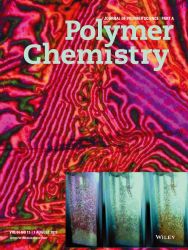
Photograph of metallic iridescent film adorns the inside cover of an academic journal
Prof. Goto was impressed by this metallic iridescence, and carried out in-depth research on the polymer structure. This was how he discovered that the elytra of the koganemushi beetle display a very similar structure. During the process of developing into an adult in the cocoon, the larva displays phase transition reactions to night/day temperature differences, and it is thought that this creates a layer of liquid crystal over a layer of solid crystal on the insect's elytra. This complex structure is the source of the beetle's iridescence. However, the beetle's elytra have a four- or five-layer structure. As yet, only the two-layer structure has been achieved in the laboratory, which is a testament to the power of nature.
Liquid crystals call to mind television and PC displays. Resolution and color reproduction is rapidly improving, but current LCD displays cannot reproduce genuine metallic iridescence. Apparently iridescent colors reproduced by LCD displays as they do because the brain fills in missing perceptual information, for example through comparisons with surrounding colors. If Prof. Goto's polymer were to be applied, then LCD displays capable of reproducing genuine metallic iridescence may become a reality.
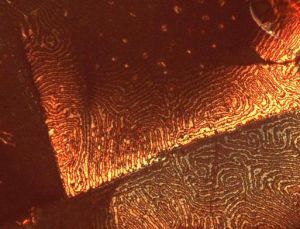
Polarization microscope photograph of the double layer polymer structure, showing a spiral liquid crystal structure atop a diamond solid crystal structure
Prof. Goto's mentor was Prof. Hideki Shirakawa, who won a Nobel Prize in Chemistry in 2000 for his discovery of conductive polyacetylene. However, when Prof. Shirakawa received his award, Prof. Goto was not actually researching polyacetylene, but liquid crystals. He had become interested in insects, and found that liquid crystals were behind the iridescence of the tamamushi beetle elytra. Since then, with the modulation of light and color as key themes, he has devoted himself to researching liquid crystals. But for this research to lead to the koganemushi beetle was unexpected.
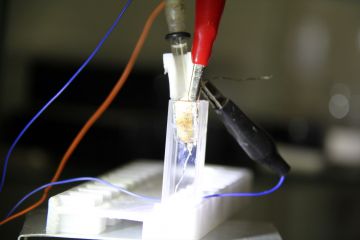
Light shined on film with current passing through it generates a gold color
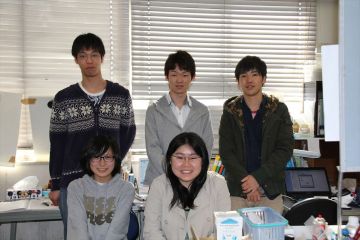
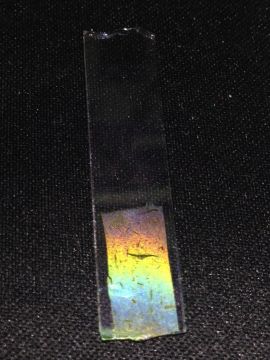
Biomimetics, the development of technology to reproduce biological structures and functioning of living organisms, has recently become an active research field. Prof. Goto's research takes the opposite approach. As he conducted his research on the new material he developed, he realized that it was like the mimetic structure of the koganemushi beetle elytra, something that had been elucidated in the 1970s in Europe. The secret to the iridescence of the koganemushi beetle elytra will be resurrected in LCD display technology in 21st century Japan. Today, Prof. Goto continues to get up early all week long to further elucidate this unexpected, astonishing mechanism he discovered.
Article by Science Communicator at the Office of Public Relations


